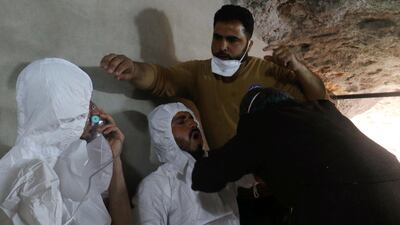The freshly dug red earth bore testament to the tragedy that befell the Al Yousef family in Khan Sheikhoun. Some 20 members had perished in the most dramatic attack of the Syrian war in 2017, a sarin gas assault that left dozens dead in this now battle-scarred town.
It was the deadliest chemical attack in Syria since the 2013 Ghouta massacre that left more than 1,000 dead and nearly led to an American intervention in the war. Instead, an agreement was brokered between Washington and Moscow that saw the supposed dismantling of the Syrian government's chemical weapons arsenal.
But an empowered regime with military momentum on its side, steadfast support from Russia and Iran, and a newly-elected American president whose top officials hinted that the Syrian leader's departure was no longer a priority, apparently felt secure enough to deploy sarin once again after months of smaller-scale chlorine attacks.
The conclusions drawn by the impartial Joint Investigative Mechanism of the UN, the Commission of Inquiry on Syria, various human rights groups and the intelligence assessments of key western powers have all concluded that sarin was used in the attack on April 4 in Khan Sheikhoun, and that the Assad regime was responsible.
When I visited the town in Idlib province two days later, I wanted to investigate the claim by Moscow that the sarin had leaked out from a rebel chemical weapons depot that was bombed. At the site of the attack, a fragment of the missile that had carried the sarin was still lodged in the ground, surrounded by small holes on the road. There was no damage to buildings nearby, just to the wall next to where the missile landed. Behind it was a dead goat, apparently suffocated by the gas.
_______________
Read more:
Staffan de Mistura urges United Nations to kick start Syrian reform process
White Helmets attacked by Russian-aligned online campaign
________________
I visited a hospital and civil defence centre that had treated the victims, and were bombed in turn hours after the chemical strike. I had seen many videos of destroyed hospitals in Syria, but seeing the rubble, damaged equipment and dust-coated patient beds for myself was another thing entirely.
There was rubble everywhere in Idlib. The drive through the province passed endless vibrant greenery punctuated by scarred towns with bombed buildings, and the occasional destroyed tank. A plane flew over our vehicle as we approached the town of Ariha, and it was surreal to look up and not know if it was coming for you or for someone else.
But the most memorable thing that day was the grief of Abdul Hamid Al Yousef after he'd buried his wife and two children, along with cousins, nieces and nephews. They suffocated in the basement of their home, where they had sought refuge instead of fleeing the area. Mr Al Yousef had rushed out to help take the wounded to hospital, not knowing it was a chemical attack, and collapsed there from inhaling a small amount of the gas.
He alternated between tears and a faraway look as the mourners streamed in and out. In that trance, he repeated the names of his family: “Aya and Ahmed, my souls. Yasser and Ahmed, my brothers who had my back. Ammoura and Hammoudi, Shaimaa, so many others.”


